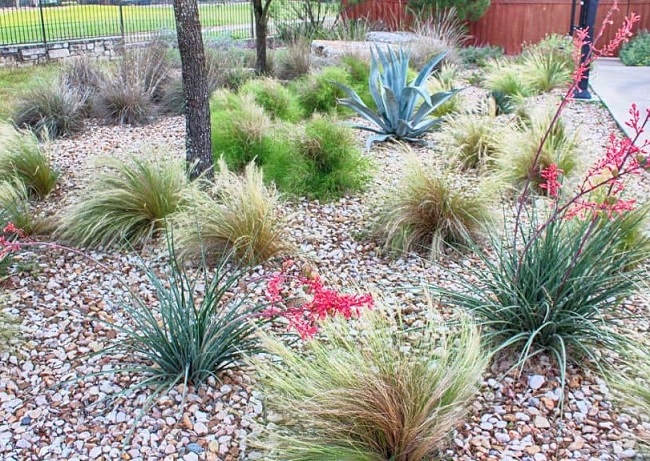
In a world where water scarcity is becoming increasingly prevalent, xeriscaping has emerged as a sustainable and environmentally conscious landscaping approach. Xeriscaping is a method of landscaping that focuses on creating visually appealing outdoor spaces while minimizing water usage. Whether you’re a gardening enthusiast or a homeowner looking to revamp your outdoor area, this beginner’s guide to xeriscaping will help you get started on the path to a stunning, water-efficient landscape.
Understanding Xeriscaping
Xeriscaping isn’t just about gravel and cacti – it’s a holistic approach to landscaping that considers the local climate, soil conditions, and plant selection to create a balanced and low-water landscape. The term “xeriscape” itself is derived from the Greek word “xeros,” meaning dry, and “landscape.”
At its core, xeriscaping aims to:
Conserve Water: Xeriscaping emphasizes water conservation by using drought-tolerant plants and efficient irrigation systems. This is particularly important in regions prone to water shortages or restrictions.
Reduce Maintenance: By selecting plants adapted to the local environment, xeriscaping can significantly reduce the need for constant watering, fertilizing, and pest control, making maintenance easier and less time-consuming.
Promote Biodiversity: Xeriscaping encourages the use of native plants, which in turn supports local wildlife, including birds, butterflies, and insects.
Enhance Aesthetics: Contrary to misconceptions, xeriscapes can be incredibly visually appealing, featuring an array of colors, textures, and architectural elements.
Steps to Creating Your Xeriscape
1. Evaluate Your Space and Soil
Before jumping into plant selection, assess your landscape’s unique characteristics. Consider factors such as sun exposure, soil type, drainage patterns, and microclimates. Understanding these elements will help you choose plants that thrive in your specific conditions.
2. Plan Your Design
Sketch out a design for your xeriscape. Decide where you want pathways, seating areas, and focal points. Group plants with similar water needs together and consider layering for visual interest. Incorporate hardscape elements like rocks, pebbles, and mulch to enhance the overall look.
3. Select Appropriate Plants
Choosing the right plants is a crucial aspect of xeriscaping. Choose native or drought-resistant plants that are well-suited to your climate. These plants have adapted to the local conditions and will require minimal watering once established. Consider a mix of groundcovers, shrubs, grasses, and succulents to create a diverse and captivating landscape.
4. Install Efficient Irrigation
While the goal of xeriscaping is to reduce water usage, some irrigation is still necessary, especially during the establishment phase of your plants. Drip irrigation, soaker hoses, and other water-efficient methods should be used to ensure that water reaches the root zones without excessive evaporation or runoff.
5. Mulch and Maintain
Apply a layer of mulch around your plants to retain moisture, suppress weeds, and regulate soil temperature. Regularly monitor your xeriscape, checking for signs of pests, disease, or any plants that may need extra attention.
6. Practice Water-Wise Habits
Beyond the initial setup, xeriscaping also involves adopting water-wise habits. Water your landscape early in the morning or late in the evening to minimize water loss through evaporation. Adjust your watering schedule according to seasonal changes and rainfall patterns.
Benefits of Xeriscaping
Xeriscaping offers a range of benefits that extend beyond water conservation:
Environmental Impact: Xeriscaping reduces the demand for water resources, which is especially vital in regions facing water scarcity. It also minimizes the need for chemical fertilizers and pesticides that can harm ecosystems.
Cost Savings: By using less water and requiring lower maintenance, xeriscaping can lead to significant savings on water bills and landscaping expenses.
Increased Property Value: A well-designed xeriscape can enhance your property’s curb appeal and value, attracting potential buyers or tenants.
Conclusion
Xeriscaping is not only a solution for water-conscious gardening but also an artistic endeavor that lets you express your creativity while promoting sustainable living. By following the steps outlined in this beginner’s guide, you can create a stunning xeriscape that not only conserves water but also contributes positively to the environment and your quality of life. Whether you have a small backyard or a larger property, xeriscaping offers a versatile and rewarding approach to landscaping that anyone can embrace.
Related Articles & Free Email Newsletter Sign Up
4 Low Maintenance Shrubs for a Beautiful and Hassle-Free Landscape
How to Grow Canadian Hemlock for Landscapes



Comment here